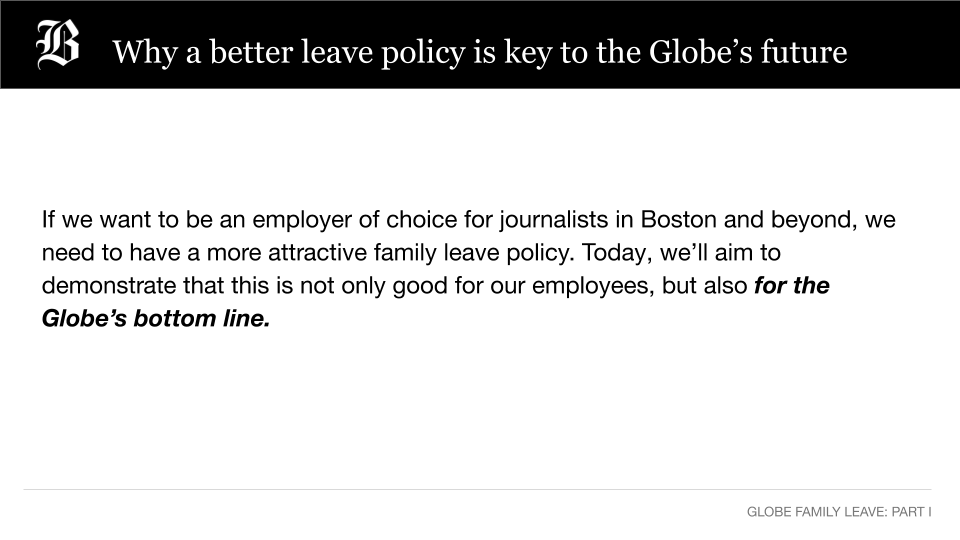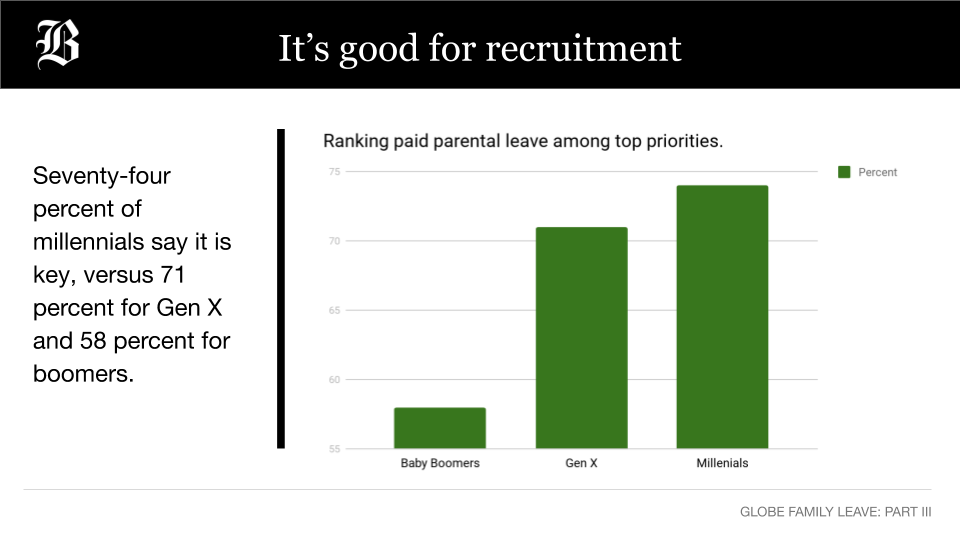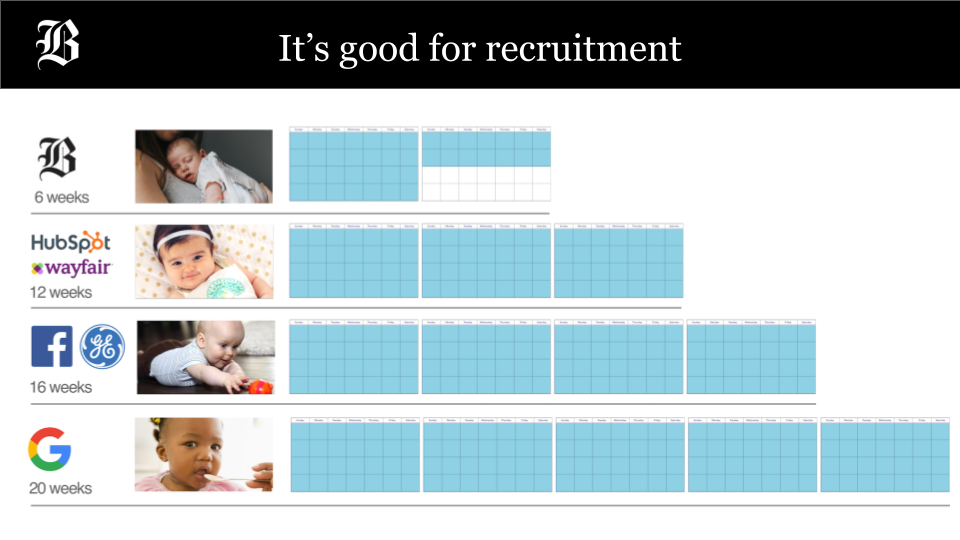Six women. Two years. One better family leave policy.
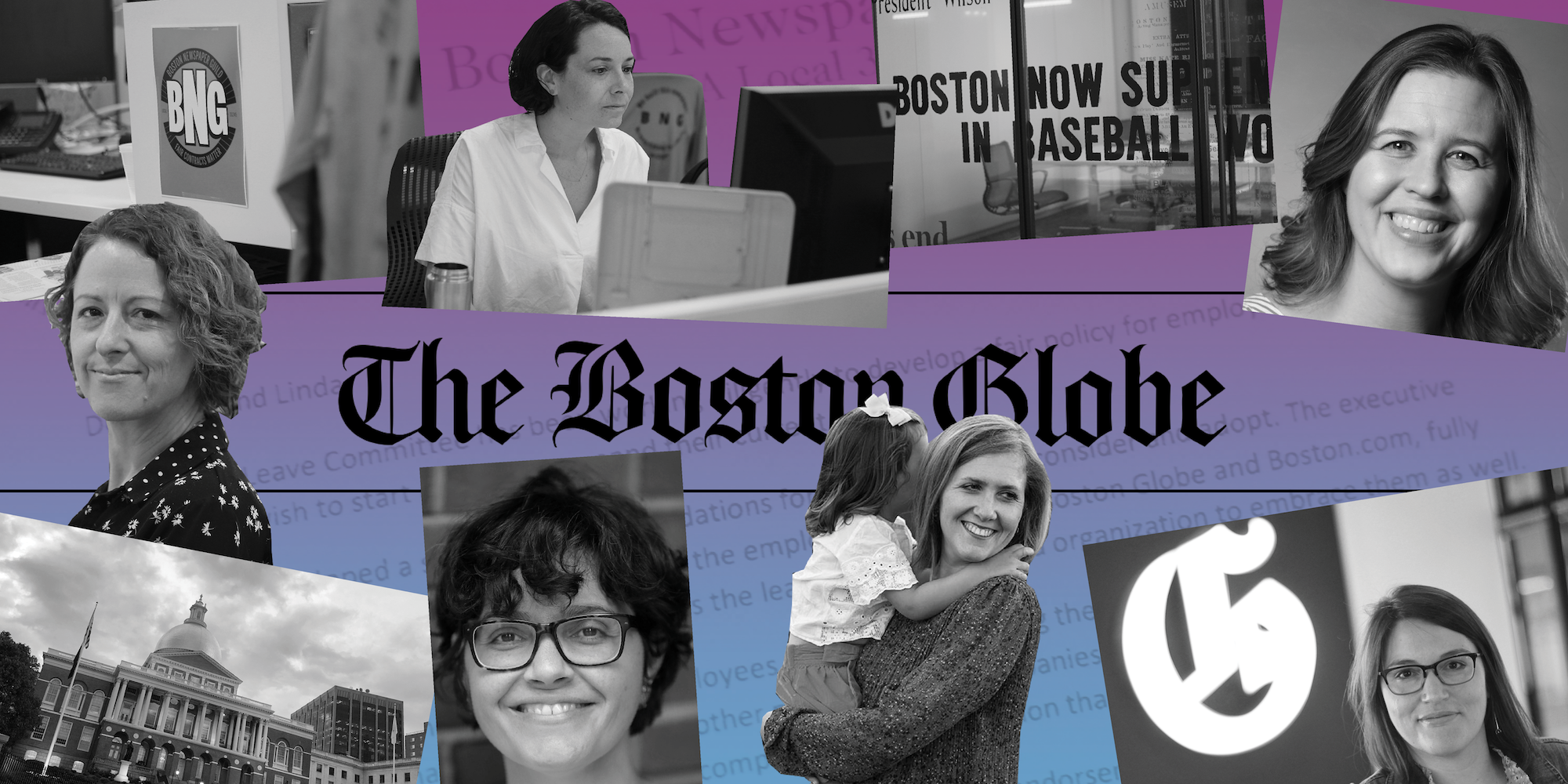
By Mel Grau
Though they never heard the word “no,” it took nearly two years for these six women to get a more robust parental leave policy for the newspaper. Here’s how they came together to fight for change during an era of employee turnover, union negotiations and the #MeToo movement.
Six women. Two years.
One better family leave policy.

Though they never heard the word “no,” it took nearly two years for these six women to get a more robust parental leave policy for the newspaper. Here's how they came together to fight for change during an era of employee turnover, union negotiations and the #MeToo movement.
Most desks sat empty, aside from red union shirts hugging backs of chairs, a sign that it was New Year’s Eve. The remaining workers at The Boston Globe were busy wrapping things up for the day, the year, when some received a notification from the higher ups.
On Dec. 31, 2018, executives announced a new family leave policy: 10 weeks paid time off for parents and caregivers, plus six additional weeks for birth mothers — a significant increase from the current policy of just six weeks.
“Congrats!” Scott Helman called out to Janelle Nanos, a business reporter at the Globe, as she walked to her desk. He knew that she and five other women on the family leave committee had pushed for this policy for 16 months.
Nanos checked her email.
Nothing.
She felt confused.
She looked at Slack.
Nothing.
When Helman forwarded her the email, Nanos realized why she didn’t get it. The policy — the one she created and lobbied for, the one she didn’t get when she gave birth to her daughter four months earlier — only applied to non-union employees.
“It was our policy, but it wasn’t for us,” Nanos said. “We were devastated.”
It was a grave disappointment in a nearly two-year saga of advocating for change at a newspaper marred by resignations, public firings, #MeToo allegations, union negotiations and business failings.
The next day — the first day of 2019 — Shira Toeplitz Center, politics editor and another woman on the family leave committee, found out she was pregnant.
‘We could do what they did’
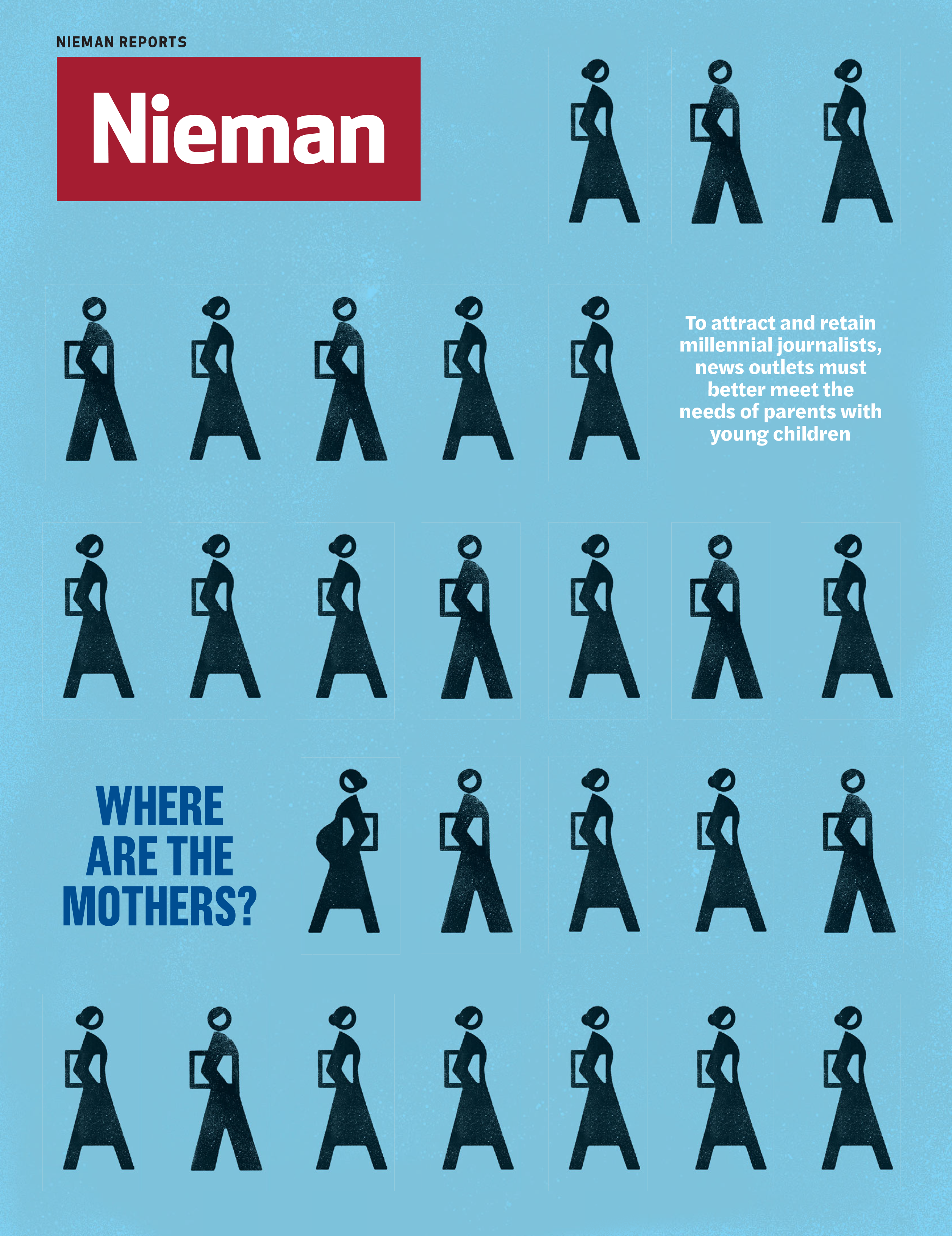
In July 2017, about a year and a half earlier, Katherine Goldstein published “Where are the Mothers?,” a viral cover story for Nieman Reports. It examined how to keep millennial women who have or plan to have children in the journalism pipeline.
A key solution: offer longer, paid family leave.
Goldstein wrote, “How both legacy organizations, hungry for journalists with 21st-century skills, and startups with nascent HR policies handle this may determine how diverse news leadership and coverage is for decades to come.”
The article, particularly Goldstein’s reporting about members of The New York Times’ Women’s Network who achieved a longer paid leave policy, stoked conversations for women working at the Globe (which was owned by the Times until 2013).
“I remember reading it on vacation (in 2017), and chiming in on Slack,” said Center, the Globe politics editor. “At some point, we were sort of like, ‘Well, we could do what they did.’”
An optimistic plan
Six women — Meghan Barr, Shira Toeplitz Center, Maria Cramer, Katie Johnston, Victoria (Vicki) McGrane and Janelle Nanos — moved the conversations to email, and The Boston Globe family leave committee was born.
“I didn’t know any of these ladies,” said McGrane, who was newly pregnant and in the throes of morning sickness. “I was working for the Globe in D.C.”
The women weren’t work wives or best friends. They were just colleagues who felt strongly that for newsrooms to survive and thrive, they needed to create an environment where women could advance in leadership.
They felt strongly that for newsrooms to survive and thrive, they needed to create an environment where women could advance in leadership.
They felt strongly that for newsrooms to survive and thrive, they needed to create an environment where women could advance in leadership.
Some were done having kids. A few were pregnant or planning to get pregnant soon. One wasn’t sure she even wanted kids. But they were all mid-career journalists with years of experience, including Pulitzer wins. So, they said, they felt like they could command the attention of leadership.
They hatched a plan in August 2017 to present a blueprint and have it implemented by management in October.
Center admits now how naive their plan sounded. It wouldn’t work out like it did at the Times.
The women
The women

Meghan Barr
Barr is the articles editor at the Globe Sunday Magazine. She has three kids: Lucy, 5; Marlowe, 3; and Teddy, 10 months. When she’s not “scrambling to just throw dinner on the table” for her children, she enjoys yoga and writing fiction.

Shira Toeplitz Center
Center recently started as the general manager for newsroom initiatives after serving as a politics editor since 2015. She enjoys playing tennis and “has a thing for rehabbing furniture.” She had a daughter, Lillian, in September 2019.

Maria Cramer
Cramer was a criminal justice reporter for the Globe and the vice president of The Boston Newspaper Guild. Cramer now works at The New York Times. Her son Gabriel is 7 and her daughter Josephine is 3.

Katie Johnston
Johnston is a 17-year veteran of the Globe and is the work and income inequality reporter. She likes to garden and wander through the woods on hikes. She has a 4-year-old daughter named Faith.

Victoria (Vicki) McGrane
McGrane is a political correspondent for the Globe. She has a 4-year-old, Grace, and 2-year-old, Eleanor. She took Cramer’s place as vice president of the union. “I like to read fiction in my spare time,” she said, “but I haven’t done that recently.”

Janelle Nanos
Nanos is a business reporter at the Globe and teaches at Boston College. She has two children: a 4-year-old, Leo, and an 18-month-old, Mackenzie. She is known as the go-to mom for advice about what to do in Boston with kids because she’s always exploring.
First up: Get support
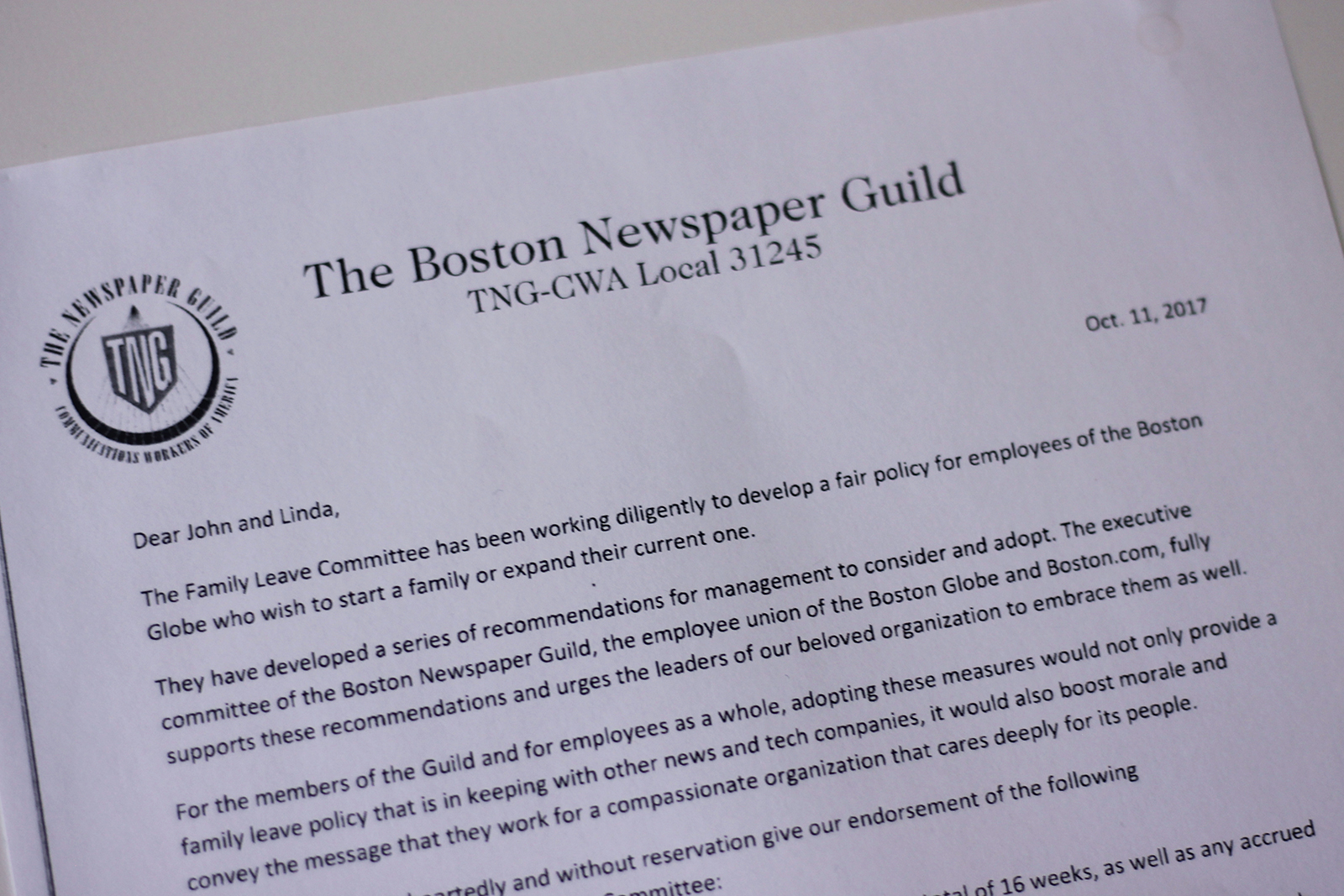
The committee’s first strategy was to collect allies. By the fall of 2017, they had talked with senior leaders and received a letter of support from the union representing around 300 Globe employees, the Boston Newspaper Guild.
Like other media companies, the Globe’s family leave policy at the time was six weeks of sick leave, fully paid through short-term disability.
- Birth mothers, fathers and adoptive parents could use the benefit.
- Employees who had a C-section received two additional weeks of paid leave at 60% of their salary.
- Employees who had been with the company for more than a year could take unpaid leave under FMLA for up to 12 weeks, but it ran concurrently with sick leave.
‘I think as everyone knows, daycare is very expensive. So we essentially went into credit card debt.’
“I think as everyone knows, daycare is very expensive. So we essentially went into credit card debt.”
“When you were done with those six weeks, you had no sick time left,” said McGrane. “So you would come back to work with no time to take off if your child got sick — which when you put them in daycare, they do.”
Multiple members of the committee also felt discouraged because the policy was applied unevenly.
“Everyone kind of negotiated their own deal,” Johnston said. “And if you had an understanding manager, you could work out comp time.”
Barr learned personally what it was like to have children under the old policy. With her daughter Marlowe, Barr took two months of unpaid time off on top of the six weeks paid through the policy. She said it still didn’t feel like enough.
“It was incredibly stressful, because we were already paying for daycare for my older child,” Barr said. “Then we lost my salary for two months. And I think as everyone knows, daycare is very expensive. So we essentially went into credit card debt.”

The Boston Globe family leave committee decided to advocate for 16 weeks total paid family leave. They felt it would be on par with their competitors and tolerable as working parents.
But by the time they gave their first presentation to editor-in-chief Brian McGrory in October 2017, the Globe had fired its chief operating officer and vice president of operations due to unresolved issues at its new printing press. This was part of what would become a mass exodus of senior leadership over the next few months.
The #MeToo movement was also gaining momentum after the Times’ and New Yorker’s investigations into Harvey Weinstein in 2017. Women came forward with credible allegations of sexual misconduct against powerful men in the media, including Matt Lauer, Mark Halperin, Charlie Rose and Garrison Keillor.
Scrutinized, news organizations looked inward. Implicated, these organizations launched internal investigations. (In May 2018, the Globe hired investigators to look into a harassment claim against McGrory in which he was accused of sending an inappropriate text to a female staffer before he was the editor. He was cleared of wrongdoing.)
Despite these distractions, the family leave committee followed Goldstein’s advice to present a data-driven business case.
“We put our reporter hats on,” said McGrane. “I remember emailing friends who worked at different publications to get the details of their maternity leave policies so we could compare. Other people here were looking at other Boston-based companies. This was the data that went into the PowerPoint, as well as research into the benefits of paid parental leave.”
The family leave committee collaborated on a presentation in 2017 that showed how The Boston Globe’s family leave policy compared to its competitors, arguing that an improved policy could help with recruitment and retention. The four slides above are excerpts from that presentation.
With Boston’s low unemployment rate, the committee focused its argument on retaining and recruiting talent.
“We at the Globe have long been sort of a feeding ground to some of the national publications,” said Center. “We have to fight to stay competitive.”
Editor McGrory was fully supportive, according to all the women on the committee. He brought the issue to the owners of the Globe, John and Linda Henry, and the committee felt encouraged.
Just a couple weeks later, in late October 2017, the committee presented its case to HR and C-suite executives, including Linda Henry and the new Boston Globe president Vinay Mehra. He had joined the Globe a few months earlier from Politico, which had recently extended its family leave policy.
“Most people in the room were receptive,” said Center.
But nothing happened. Months passed. Many people who had been in that room no longer worked at the Globe.
Low on the list
After internal investigations, some of which took place before the Weinstein fallout, the Globe reported in December 2017 about instances of sexual harassment and misconduct at the organization. Men terminated throughout 2017 included a mid-level manager, a contract worker and a political reporter. For much of 2017 and 2018, the Globe’s human resources department seemed to be occupied with handling these types of allegations and urgent personnel concerns.
Family leave fell down the priority list.
‘We felt like this was a feel-good policy and something that says to your staff that, “We believe in you. We support you.”’
“We felt like this was a feel-good policy and something that says to your staff that, ‘We believe in you. We support you.’”
On top of #MeToo matters, a total of eight C-suite executives, vice presidents or directors at the Globe were fired or resigned between July 2017 and January 2018, including the top leader in HR. Even for news organizations accustomed to change, this upheaval was remarkable. Employee morale was low.
“People are leaving, and we’re dealing with the #MeToo issues that everyone in the industry is dealing with,” Nanos said. “We felt like this was a feel-good policy and something that says to your staff that, ‘We believe in you. We support you.’”

John Henry, the Globe’s owner and publisher, was more focused on resetting what he called a wasteful and inefficient business culture. In an email to the Boston Business Journal in January 2018, he said, “The biggest fear in this industry, but especially at the Globe, should be the status quo.”
The family leave policy was put on hold until the Globe could hire a new director of human resources. Six months had passed since the women formed the family leave committee.
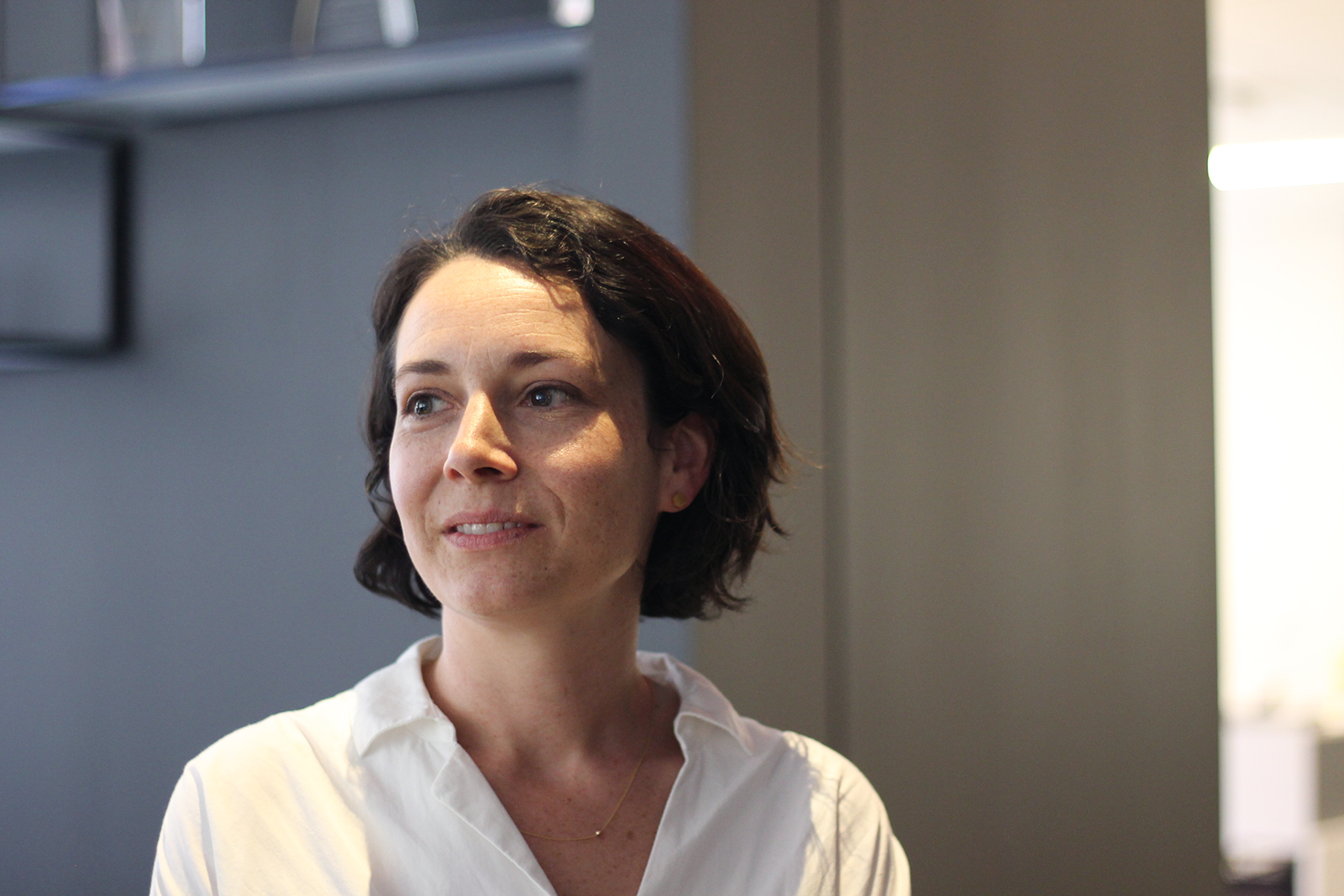
While the policy stalled, bellies grew. McGrane moved from D.C. to Boston in February 2018, one month before her daughter was due.
“I had resolved myself that it wasn’t going to happen,” McGrane said. “I was going to give birth before the policy changed. But gosh darn it, I’m gonna keep pushing. My motivation had never been purely selfish.”
Around the same time, Nanos told the women on the family leave committee — now some of her best friends — that she was also expecting.
“Babies actually happened faster than some of these processes.”
“I was not pregnant when this started, but not only did I get pregnant, I had a baby and came back from maternity leave before this had been sorted out,” Nanos said. “Babies actually happened faster than some of these processes.”
On March 4, 2018, McGrane gave birth to her second daughter, Eleanor. She worked full-time until then and ended up taking six months maternity leave, mostly unpaid.
“I had retained placenta that they didn’t discover until nine weeks after birth, which can be a very serious complication,” McGrane said. “Under the Globe’s plan … they were saying I should have been back at work by then. It was hard to find the time to go to the doctor to investigate the cramping I was having as it were, with a newborn baby and an older daughter at home.”
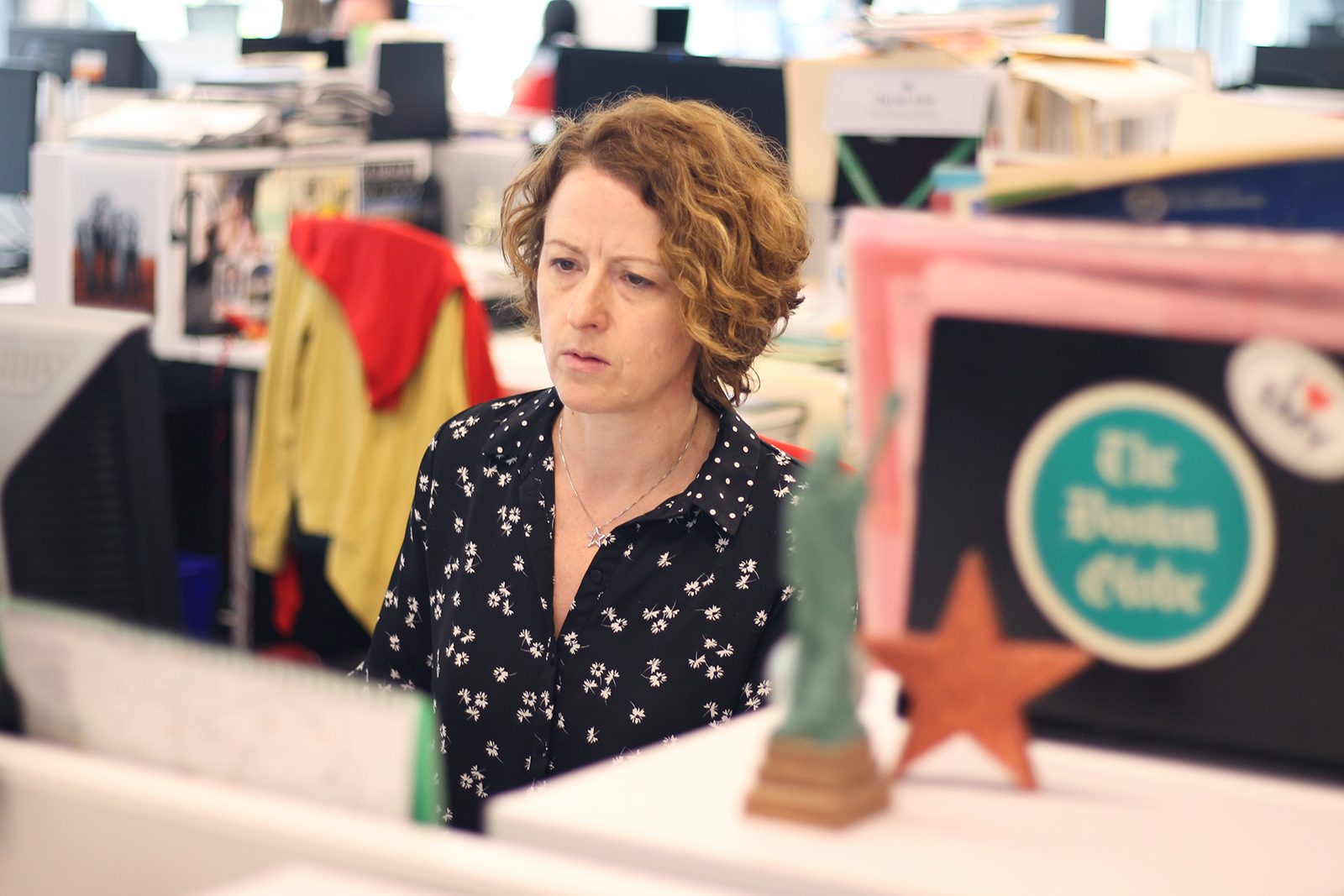
By spring, the Globe had begun rebuilding the business side of the organization. Claudia Henderson started as chief human resources officer in March 2018. Re-energized but one woman down with Vicki on maternity leave, members of the committee gave Henderson the same presentation that they had given to McGrory, Mehra and Henry.
By all accounts, Henderson was supportive. She asked the committee to keep building the business case by calculating the cost of 16 weeks paid family leave.
The committee again did its homework. Again, there was a delay.

Summer arrived. It was one of the most sweltering seasons in Boston since the National Weather Service began recording in 1872, the same year The Boston Globe was founded.
The 2018 midterm election was in full swing, while the Boston Red Sox kept hitting it out of the park. They’d go on to win the World Series. Women would go on to win more elections across the country than at any other point in American history, including Ayanna Pressley, the first African-American woman to represent Massachusetts in Congress.
The family leave committee, now a year old, waited for a win of its own.
It didn’t come when Massachusetts passed a paid family and medical leave act in June. The law will allow new parents up to 12 weeks of paid leave starting in 2021. The Boston Globe editorial board wrote in support of the law.
The win didn’t come from the committee’s latest emotional appeal. To showcase the negative impact of the current policy on Globe employees, the committee asked staff to write personal letters about their experiences.
And the win certainly didn’t come from the next high-level meeting that summer when senior executives said implementing the policy would legally require a change to language in the union contract regarding sick days. In other words, the union got involved, and the policy became linked to sick days.
With the union’s contract set to expire in a few months, the family leave committee thought it would be the most expedient way to implement the policy. Around eight employees were expecting babies by now, including Nanos, who was only a few weeks away from her due date.
“It was a lot,” Center said. “I remember really wanting to get this done for them.”
But the negotiations were largely out of their control now that the policy was on the bargaining table.
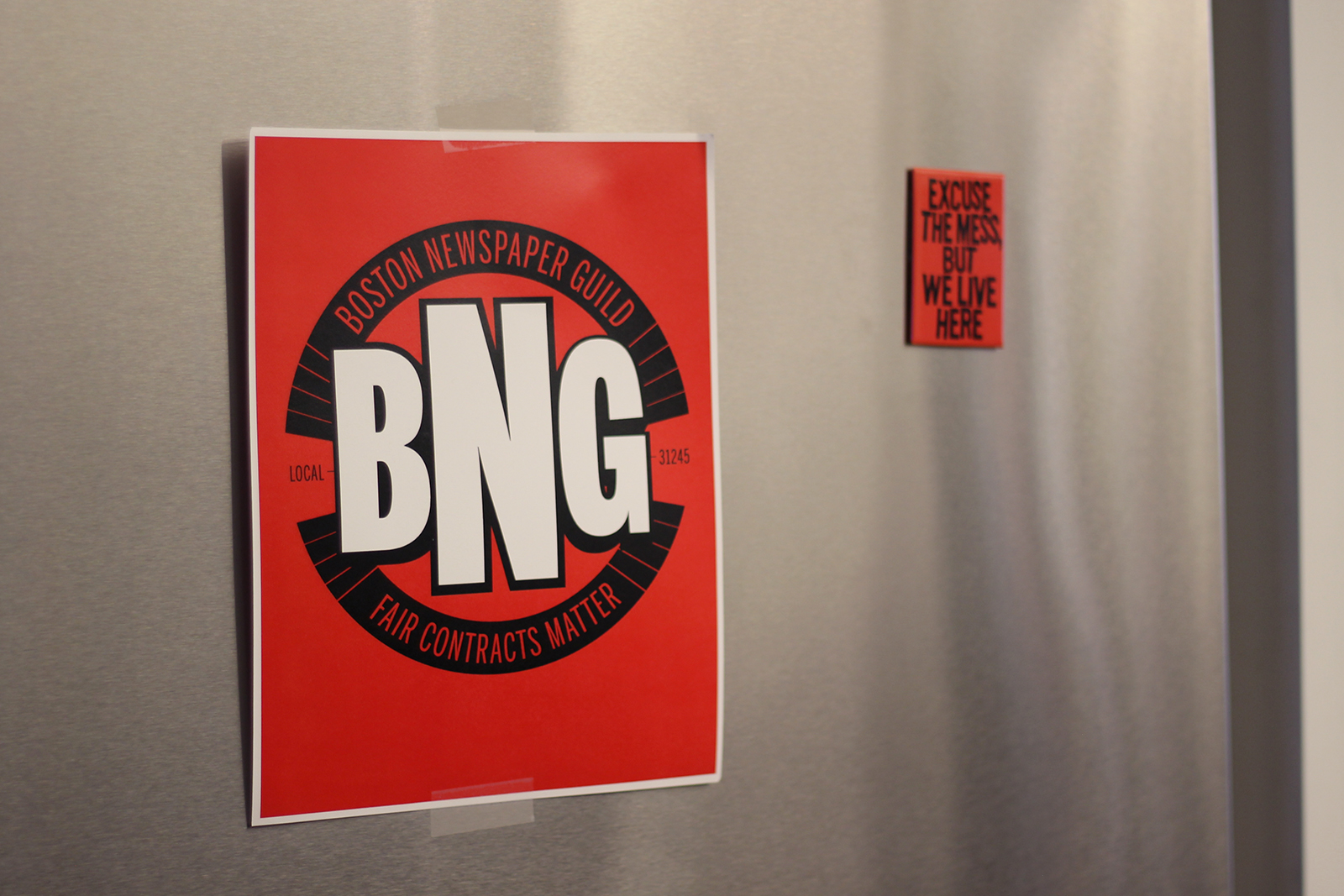
On Aug. 10, 2018, Nanos gave birth to her daughter, Mackenzie. She used the family leave policy through October. Then, she took unpaid time off until early December. Even though she wasn’t in the newsroom, she still worked.
She wrote a story for the Women & Power issue in between her daughter’s naps. Then she came into the office to do an internal Q&A event for the Globe’s female staff while a colleague watched over Mackenzie. She also still called in to have strategy meetings with the family leave committee.
“I would do the group calls,” Nanos said, “breastfeeding my baby.”
These conversations were necessary as union negotiations intensified throughout the fall.
By this point, the family leave committee wasn’t only asking for 16 weeks paid family leave. Members wanted to make sure that employees who had children during the past year would have access to the benefits when they eventually took effect.
“Fighting for retroactive benefits was part of our game plan all along, but it became even more important once Vicki and Janelle had their babies under the old policy,” said Center.
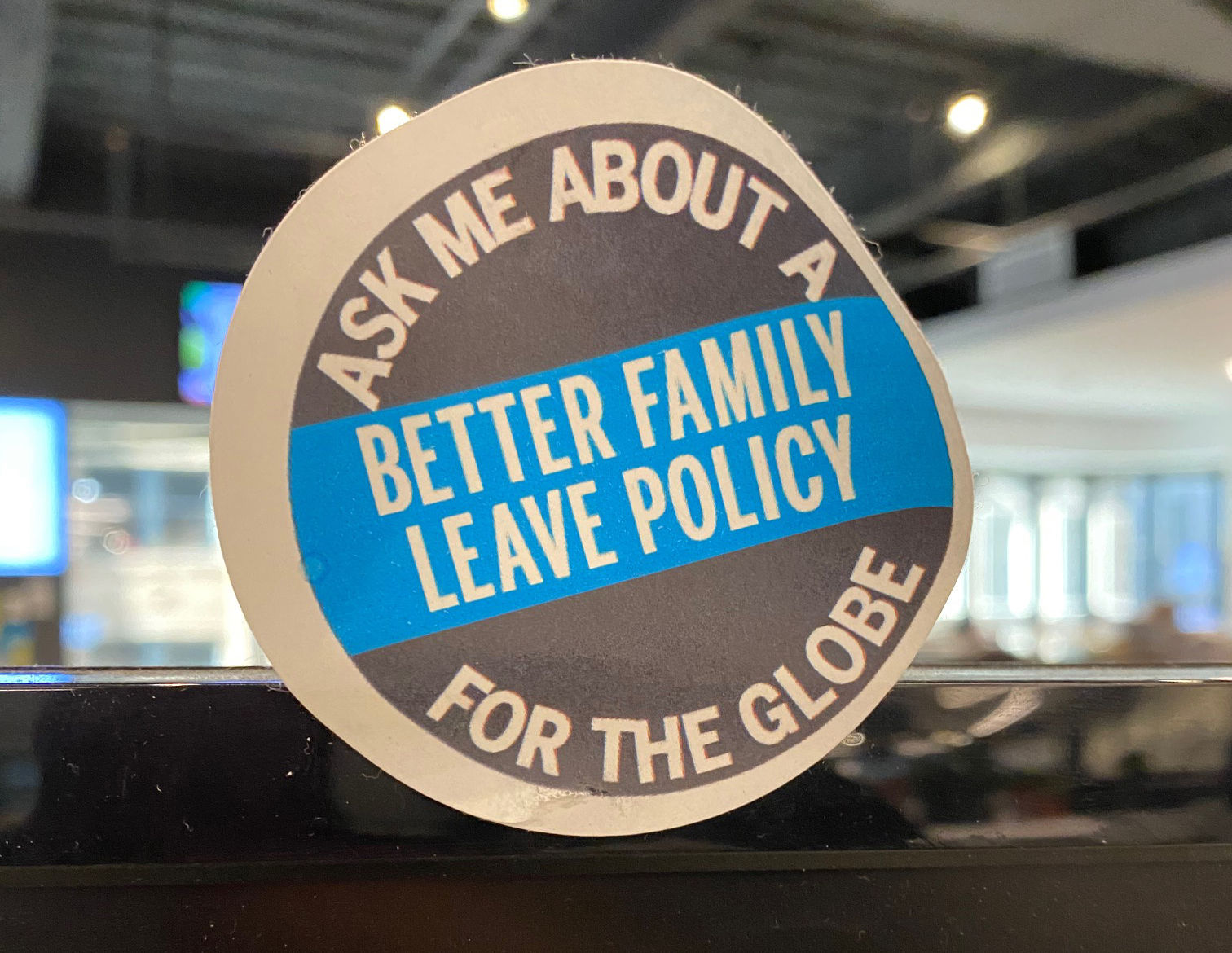
For the committee of six women, one of the advantages of entangling the family leave policy with union negotiations was the broader base of support.
In November 2018, the committee gave a series of presentations about the draft policy to the newsroom as a whole. In December, Boston Newspaper Guild members wore stickers to the company holiday party to show support for the family leave policy.
When senior executives announced the family leave policy for non-union staffers on New Year’s Eve 2018, many people were confused.
In January 2019, shortly after Shira discovered she was pregnant and as Barr neared her third trimester with her third child, union leadership and management went back to the negotiation table with Cramer at the helm.
“People were losing sleep and crying in the newsroom,” said Cramer, the union rep on the family leave committee at the time. “There was also a sense of betrayal that the company was now creating a quid pro quo when before there wasn’t one. We had been told by management that the object was not to extract anything from members. Then, at the negotiating table, that is exactly what they said we needed to do: give up sick days in exchange for family leave.”
On Feb. 3, 2019, the New England Patriots won the Super Bowl.
Three days later, the women of The Boston Globe family leave committee finally got their win.
‘I was in the grocery store. And I almost started crying because I was so relieved.’
“I was in the grocery store. And I almost started crying because I was so relieved.”
Union leadership and management came to an agreement: Guild members would receive 10 weeks of fully paid leave for parents, with an additional 6-8 weeks of short-term disability for birth mothers. This policy, the same one that landed on New Year’s Eve for non-union employees, was effective immediately even though contract negotiations wore on.
“I was the first person Maria called because I was pregnant,” Barr said. “And she was so excited to tell me because she had been in the room when they made it happen. I was in the grocery store. And I almost started crying because I was so relieved.”
The Globe also gave five extra paid weeks off to anyone who had a baby in 2018 — weeks people like McGrane and Nanos could use in 2019 or 2020.
In a statement to Poynter, Boston Globe Media said it “will continue to implement programs that create the most welcoming, supportive environment for working parents.” Recently, the Globe installed a hospital-grade pump in the mother’s room.
Despite some union members feeling like they sacrificed precious sick time, the policy was widely well-received.
“Any concern we had about people in the newsroom who would somehow begrudge this policy, it was the exact opposite,” said Nanos. “People were so thrilled.”

The family leave policy at The Boston Globe has been in place for one year. Here’s how it affected the women of the family leave committee:
Meghan Barr was one of the first women to take advantage of the new policy when she gave birth to her third child, Teddy, in April 2019.
“It’s not an exaggeration to say that this policy was life-changing in the best way,” Barr said. “I was able to stay home with my son for nearly five months without worrying about how I was going to pay the bills each month, and for that I’m incredibly grateful. I’m really proud of what we accomplished. It’s also been wonderful to see several new fathers in the newsroom take 10 weeks of paid time off to spend time with their newborns this year. That’s still a rarity at most companies, unfortunately, and I’m glad the Globe is helping to pave a progressive path toward fixing that caregiver imbalance.”
Shira Toeplitz Center had her daughter in September 2019. After her maternity leave, she got promoted from politics editor to general manager for newsroom initiatives in February 2020.
“I’m not sure I would have had the wherewithal or energy to do this if I didn’t have the paid leave that I had with my daughter,” Center said. “Instead, when I came back to the newsroom, I was ready to tackle a new challenge.
“Making this happen is one of the highlights of my career and, I would argue, one of the best things we’ve done for journalism in our region because it keeps women in leadership and parents in a newsroom that should strive to be reflective of who we cover.”
Maria Cramer and her husband both took jobs at The New York Times in late 2019.
“I loved working at the Globe,” said Cramer. “Management made an agonizing decision that much easier.”
She counts getting the policy passed and working with the family leave committee as major highlights. “The effort had nothing to do with journalism, but it was one of the most rewarding experiences of my entire career,” she said. “I love these women.”
Katie Johnston still thinks the road to getting the family leave policy was long and frustrating.
“Now that it’s in place, though, it’s so rewarding to talk to expectant moms and dads about how they’re going to spend their time with their babies and to see how happy they are to have it,” Johnston said.
Vicki McGrane is now the vice president of the Boston Newspaper Guild. She is leading the ongoing contract negotiations.
“The new policy has had a hugely beneficial effect on the lives of Globe employees,” said McGrane. “I am grateful that, as fraught as it was at times, the company heard us and worked with us to make this important improvement. I think it’s made the Globe a stronger company.”
Janelle Nanos, now the mother of two young children, has complicated feelings about the policy.
“The pace at which it was handled was frustrating for a lot of people involved,” she said. “People like me weren’t able to use the policy.”
She said she hopes that other women will use their story as a playbook, much like they used the strategies outlined in the Nieman Reports story. “This is something that can be done internally and respectfully. We can make this happen industry-wide.”
More from Poynter
How Emily Ramshaw plans to build the most representative newsroom in America
Mothers aren’t broken, it’s the system — and other lessons I’ve learned in the last two years
How to keep your sanity as you dismantle the status quo in newsrooms
The news business is unfair to journalists with children. Let’s change it for the better.
This story was originally published on February 25, 2020
Written by Mel Grau
Designed by Ren LaForme and Sara O’Brien
Edited by Barbara Allen


